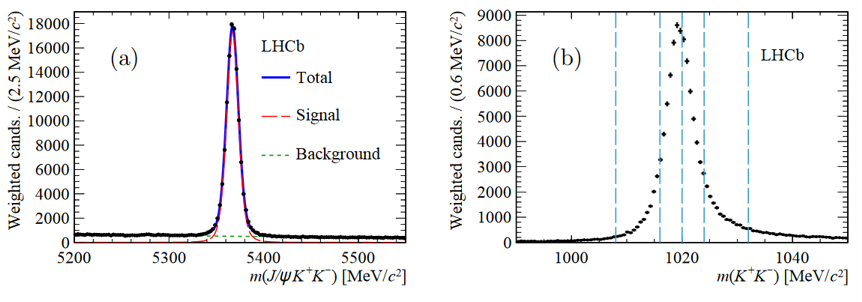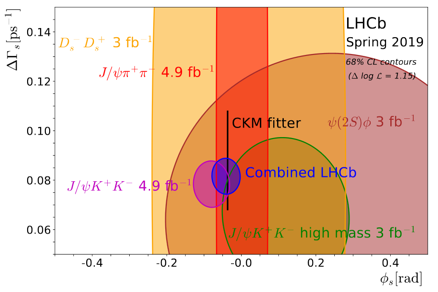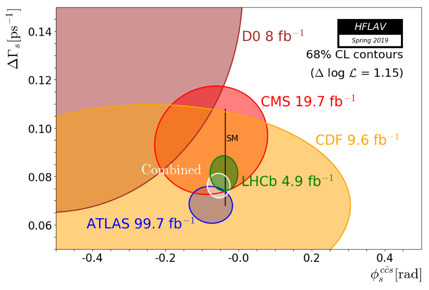φs = -0.041±0.025 rad (LHCb)
φs = -0.055±0.021 rad (World)
The LHCb collaboration has submitted for publication an updated measurement of the CP-violating phase φs in Bs0 meson decays. The precision measurement of φs is one of the most important goals of the LHCb experiment.
In the wonderful world of quantum mechanics a Bs0 meson can decay directly or oscillate into Bs0 meson and then decay. In analogy to the two-slit quantum mechanics experiment, these two modes of decay can interfere. Interference like this is one of the key ingredients for CP violation to occur. CP violation means that particles and their antiparticles have different properties and behave in different ways; it’s required to explain why the universe we live in consists mainly of matter rather than antimatter. In this case, the CP violation would manifest itself as a nonzero value of the phase φs.
Within the Standard Model, the value of φs can be calculated precisely from other measurements. The predicted value of φs is small, about -0.037 rad, and New Physics effects could therefore change its value significantly.
In order to obtain this new result, LHCb physicists measured the decay-time-dependent CP asymmetry in Bs0→J/ψK+K– decays using proton-proton collision data collected with the LHCb detector at a centre-of-mass energy of 13TeV in 2015 and 2016 of the LHC Run 2, corresponding to an integrated luminosity of 1.9fb-1. The CP-violating phase φs was measured using a sample of approximately 117 000 decays with a K+K– invariant mass in the vicinity of the φ(1020) meson. The images below show (a) the J/ψK+K– invariant mass distribution peaking at the Bs0 meson mass, and (b) that of the K+K– combination accumulated around the φ meson mass.
The reported value is φs = -0.083±0.041±0.006 rad, consistent with expectations based on the Standard Model and with a previous LHCb analysis of this decay using data recorded at centre-of-mass energies 7 and 8 TeV in the LHC Run 1. The combination of the Run 1 and Run 2 results gives φs = -0.080±0.032 rad. This result is then combined with the recently published measurements of φs using Bs0→J/ψπ+π– decays obtained with the same dataset, and with previous independent LHCb results. The combined value φs = -0.041±0.025 rad is consistent with expectations based on the Standard Model, and is the most precise experimental determination.
The phase φs is not the only interesting parameter that can be measured with Bs0-Bs0 oscillations. Following the rules of quantum mechanics, each of the particles can be expressed as a different combination of two quantum states that have slightly different masses and decay widths (and thus slightly different lifetimes). Their mass difference, Δms, determinates how fast Bs0 and Bs0 oscillate into each other, see 15 march 2011 news. The difference of their decay widths, ΔΓs, was measured in this new analysis together with the value of φs and other parameters such as the difference between the Bs0 and B0 lifetimes.
The left image above shows the various LHCb measurements of φs used for the combined result, and the combined contour (in blue) in the φs-ΔΓs plane. The Bs0→J/ψK+K– (magenta) and Bs0→J/ψπ+π– (red) contours are both marked 4.9 fb-1 and represent combinations of Run 1 and Run 2 data. The Standard Model expectations obtained by the CKMfitter group is indicated by the thin black rectangle (and a similar result is also obtained by the UTFit collaboration). The right image above shows the comparison of the LHCb combined result (in green) with results from other experiments, including the recent ATLAS measurement (in blue), and the world combination by the HFLAV group (in white). The world combination gives φs = -0.055±0.021 rad.
Read more in the LHCb paper and LHCb CERN seminar.



